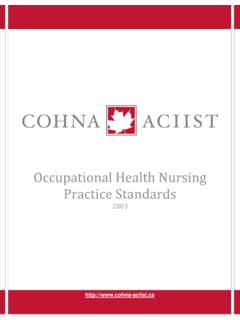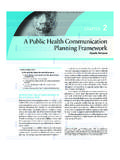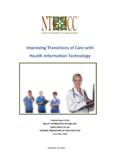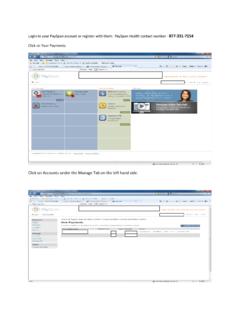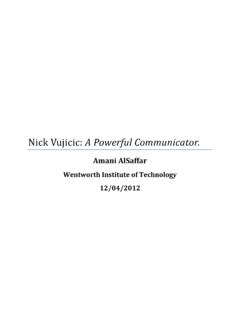Transcription of The Health Communicator’s
1 July 2011 The Health communicator s Social Media Toolkit Table of Contents Social Media Introduction Social Media Overview 1 Getting Your Feet Wet With Social Media 2 CDC s Top Lessons Learned from Using Social Media 4 Developing a Social Media Strategy 5 Social Media Monitoring and Evaluation 6 Governing Social Media Efforts 6 Social Media Tools Buttons and Badges 8 Image Sharing 9 Content Syndication 10 RSS Feeds 11 Podcasts 13 Online Video Sharing 15 Widgets 18 eCards 19 Mobile Technologies 21 Twitter 27 Blogs 32 Facebook 36 Social Media Campaign Example CDC Vital Signs Campaign 40 More Social Media Resources 46 Social Media Communications Strategy Worksheet 47 Social Media Evaluation Worksheet 50 References 53 A guide to using social media to improve reach of Health messages, increase access to your content, further participation with audiences and advance transparency to improve Health communication efforts.
2 August 6, 2010 Update July 2011 The Health communicator s Social Media Toolkit This toolkit was developed by the Electronic Media Branch, Division of News and Electronic Media, Office of the Associate Director of Communication at the Centers for Disease Control and Prevention (CDC). It was designed to provide guidance and to the share lessons learned in more than three years of integrating social media into CDC Health communication campaigns, activities and emergency response efforts. In this guide, you will find information to help you get started using social media from developing governance to determining which channels best meet your communication objectives to creating a social media strategy.
3 You will also learn about popular channels you can incorporate into your plan, such as blogs, video-sharing sites, mobile applications and RSS feeds. This toolkit is intended for a beginner audience, although some viewers with an intermediate level may find parts of the toolkit useful. Acknowledgments A number of dedicated and hardworking professionals contributed to the creation and revised 2011 edition of this toolkit. For their invaluable input, we would like to thank the following CDC staff and contractors: Diane Brodalski, BS, Project Lead (Northup Grumman Contractor) Heather Brink, MPH Jessica Curtis, BFA (Northup Grumman Contractor) Shelly Diaz, BS Jessica Schindelar, MPH Curt Shannon, BA Cari Wolfson, MS, Focus on U!
4 We also acknowledge and thank Carol Crawford and Dogan Eroglu for their review and excellent contributions to the guide. Thanks to the staff of CDC s Electronic Media Branch, whose technical knowledge and expertise have enhanced this toolkit s content and quality. 1 SOCIAL MEDIA INTRODUCTION Social Media Overview In the last several years, the use of Facebook, YouTube, Twitter and other social media tools to disseminate Health messages has grown significantly, and continues to trend upward. Using social media tools has become an effective way to expand reach, foster engagement and increase access to credible, science-based Health messages.
5 Social media and other emerging communication technologies can connect millions of voices to: Increase the timely dissemination and potential impact of Health and safety information. Leverage audience networks to facilitate information sharing. Expand reach to include broader, more diverse audiences. Personalize and reinforce Health messages that can be more easily tailored or targeted to particular audiences. Facilitate interactive communication, connection and public engagement. Empower people to make safer and healthier decisions. Integrating social media into Health communication campaigns and activities allows Health communicators to leverage social dynamics and networks to encourage participation, conversation and community all of which can help spread key messages and influence Health decision making.
6 Social media also helps to reach people when, where and how they want to receive Health messages; it improves the availability of content and may influence satisfaction and trust in the Health messages delivered. Likewise, tapping into personal networks and presenting information in multiple formats, spaces, and sources helps to make messages more credible and effective. Over the years, the internet has changes people s relationships. Although doctors, nurses and other Health professionals continue to be the first choice for most people with Health concerns, online sources, including advice from peers, are a significant source of Health information in the US.
7 The social life of Health information is dynamic. Two forces are driving online Health conversations: 1) the availability of social media tools and 2) the increased desire and activity, especially among people living with chronic conditions, to connect with each other. (Fox, S. 2011). 2 Getting Your Feet Wet With Social Media There are a variety of social media tools that can be utilized as part of an integrated Health communications program. Tools range from easily downloadable products, such as buttons and badges, that can be implemented with minimal resources, to engagement tools that foster two-way communication and ongoing interaction, such as social network sites.
8 Generally, as you progress from dissemination to engagement, more resources are needed for set-up and maintenance and the potential exists for greater participation, learning and sharing. We recommend giving careful consideration to the amount of resources and expertise required before deciding on the tools you may want to use. It is often beneficial to start with social media projects that may be considered low risk or use fewer resources at the outset, and then adopt more engaging tools that may require additional resources, expertise and leadership support.
9 The table below documents specific social media tools, showing the continuum from dissemination to engagement, as well as the resources generally needed to implement Health communications activities in many popular channels. The Social Media Tools section of this toolkit provides an overview of the tools and how they may help you meet your Health communication objectives. 3 CDC s Top Lessons Learned from Using Social Media During the last four years, the CDC social media team has learned a number of lessons we want to share with you. We hope these lessons will help you in developing, implementing and evaluating strong social media practices in your organization.
10 1. Make Strategic Choices and Understand the Level of Effort Be strategic and follow demographic and user data to make choices based on audience, communications objectives and key messages. Be sure to assess the level of effort needed to maintain these channels such as time and commitment. Often, the resources needed to start and maintain social media projects are different than traditional communication efforts. 2. Go Where the People Are Social media can help reach people where they are millions of people use social media and spend a lot of time in these spaces learning, sharing and interacting.










